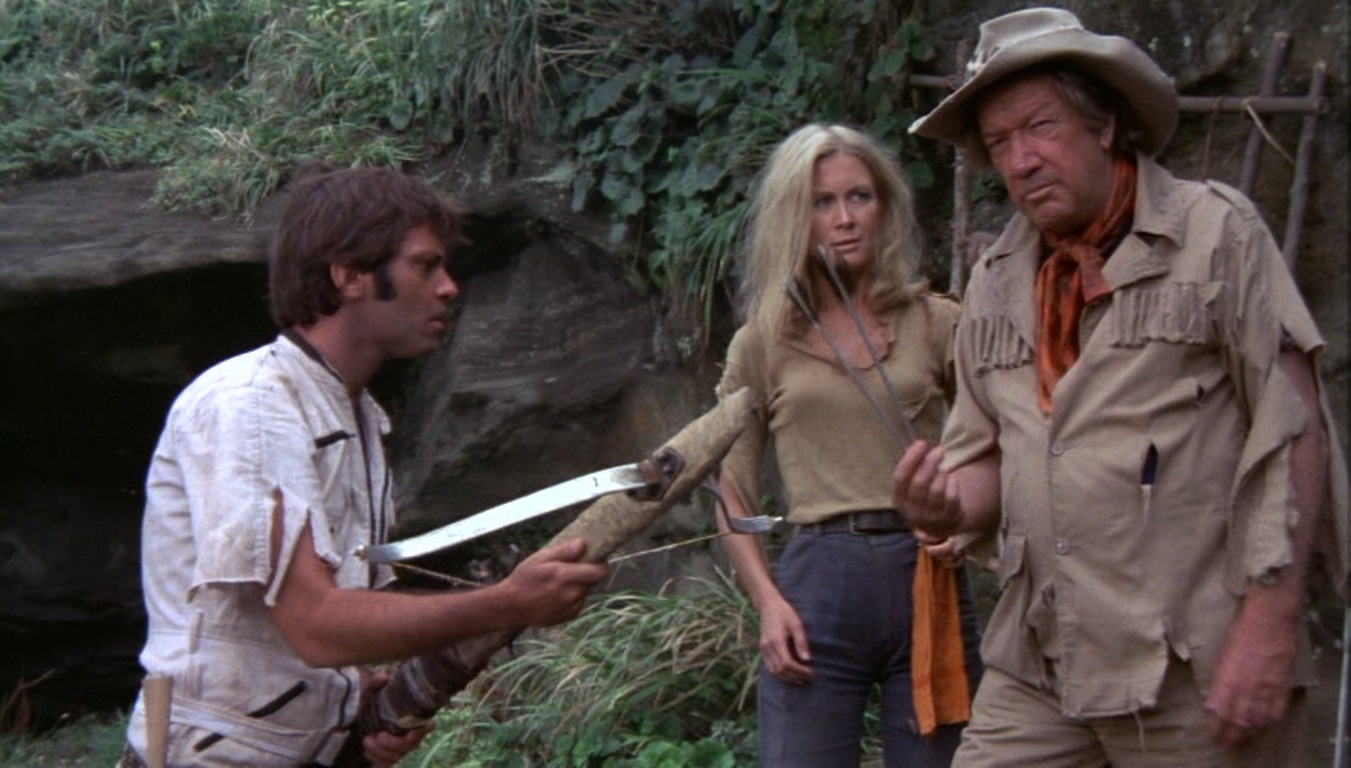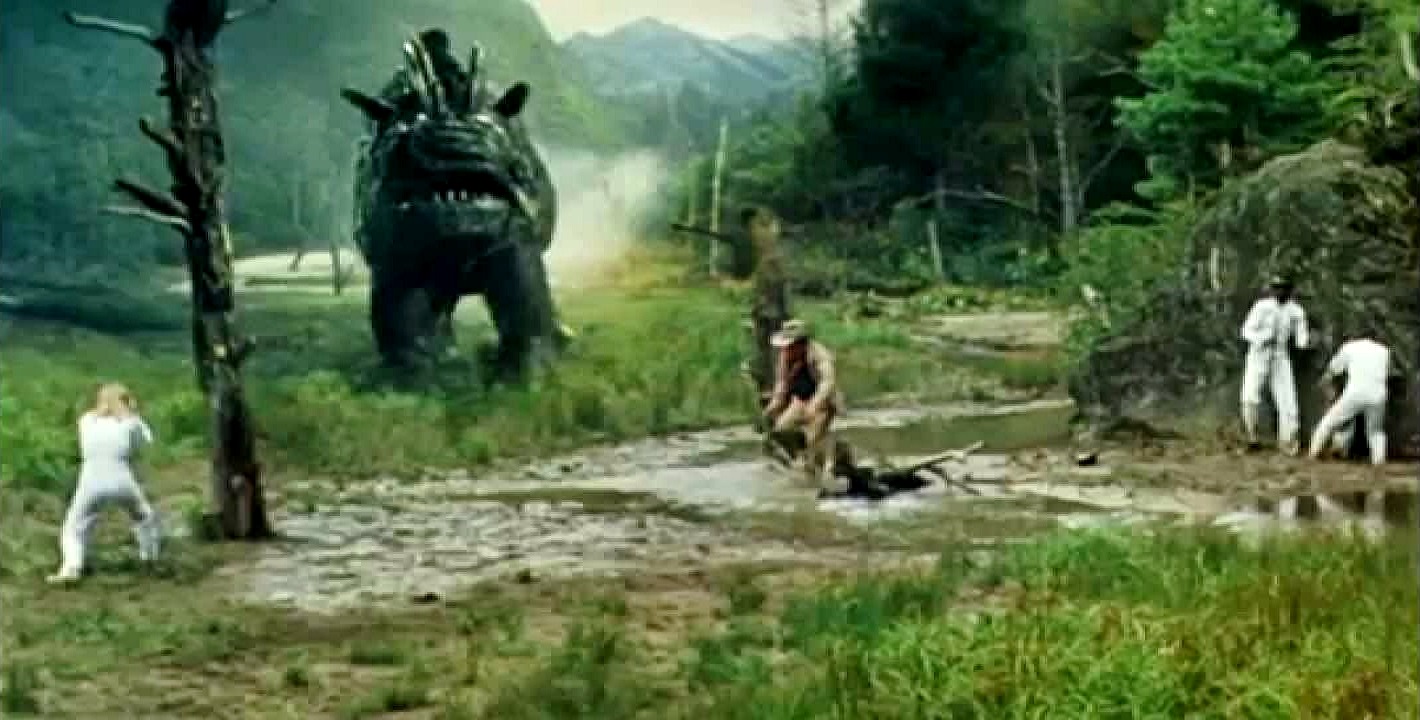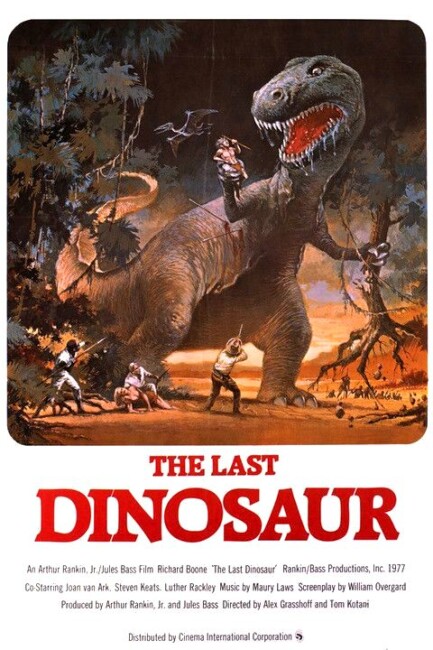USA/Japan. 1977.
Crew
Directors – Alex Grasshoff & Tom Kotani, Screenplay – William Overgard, Producers – Jules Bass & Arthur Rankin, Jr, Photography – Shoji Ueda, Music – Maury Laws, Special Effects – Kazuo Sagawa, Art Design – Kazuhiko Fujiwara. Production Company – Rankin-Bass Productions, Inc./Tsubaraya Productions
Cast
Richard Boone (Masten Thrust Jr), Joan Van Ark (Francesca ‘Frankie’ Banks), Steven Keats (Chuck Wade), Luther Rackley (Bunta), Tetsu Nakamura (Dr Kawamoto), Mazumi Sekiya (Hazel), Nancy Magsig (Thrust’s Girl on the Plane), William Ross (Hal), Carl Hansen (Barney)
Plot
Oil baron Masten Thrust Jr, one of the wealthiest men in the world and a renowned big game hunter, holds a press conference. There he announces that one of his expeditions found a prehistoric lost world in the Arctic before all but one survivor was wiped out by a tyrannosaurus rex. He is planning to personally return to the region with a second expedition, although swears it is not to hunt the T. Rex. When Thrust finds that the press photographer selected to join the expedition is a woman, Francesca Banks, he refuses, only for Francesca to charm him. They set forth in a polar borer, drilling through the Arctic crust and emerging into the humid prehistoric land where dinosaurs and cavemen roam. However, the T. Rex destroys the camp and drags the borer away, stranding them there. As their survival drags on for months, the others see that Thrust has made it his personal vendetta to kill the T. Rex and that his single-minded obsession is endangering their survival.
The creative team of Jules Bass and Arthur Rankin, Jr emerged during the 1960s with stop-motion animated seasonal holiday tv specials like Rudolph the Red Nosed Reindeer (1964), Frosty the Snowman (1969) and The Year Without a Santa Claus (1974). They also made the occasional cinematic outing such as Willy McBean and His Magic Machine (1965) and Mad Monster Party (1967). They hit their creative peak towards the end of the 1970s/early 80s with a string of animated films usually made for television, with the likes of The Hobbit (1977), The Return of the King (1980), The Flight of Dragons (1982) and The Last Unicorn (1982). Most of their output was animated and for television but towards the end of the 1970s they branched out to make several live-action tv movies with works like The Last Dinosaur, The Bermuda Depths (1978) and The Sins of Dorian Gray (1981). They eventually closed up shop in 1987.
While Rankin-Bass’s earlier films like Willy McBean and King Kong Escapes (1967) had taken advantage of Japanese films and rehashed them, writing their own names in as directors, The Last Dinosaur was actually made as a Japanese co-production with a Japanese co-director and supporting cast. The film was originally intended for theatrical release and was seen in theatres in some part of the world but was only screened as a tv movie in the US.

The lost world film – wherein adventurers come across some unexplored plateau or region of the world where prehistory has not ended and dinosaurs still roam – has had a popularity on screen ever since the adaptation of Arthur Conan Doyle’s The Lost World (1925), the genre hitting a peak with King Kong (1933). The lost world film was in particular vogue during the 1970s with the success of works such as Disney’s The Island at the Top of the World (1974) and the British-made tetraology The Land That Time Forgot (1974), At the Earth’s Core (1976), The People That Time Forgot (1977) and Warlords of Atlantis (1978), all of which set the genre back in the great Victorian Age of Exploration. The film that The Last Dinosaur resembles the most in terms of plot though is the earlier B movie The Land Unknown (1957). (For a more detailed of the genre see Lost World Films).
The Last Dinosaur is an average entry in the lost world genre – no more, no less. The dinosaur effects are competent, around the same level as the typical Godzilla film that Japan was putting out around this time. Like the Godzilla films, the dinosaurs are played by extras in rubber suits that are optically inserted into the live-action footage. (Though the film is co-produced by a Japanese production company called Tsuburaya Productions, this is no relation to Godzilla effects creator Eiji Tsuburaya).
The action is okay, although the plot does slow down during the latter half amid the scenes of the group’s not terribly interesting attempts to survive in the wild. (During the course of this their clothing is rendered in tatters, while Joan Van Ark’s boots remain shiny and brand new). This is interspersed with occasional encounters with cavemen and dinosaurs but the plot lacks much drive except for Richard Boone’s obsession with killing the T. Rex.

The cast is an oddity. Most of them were never heard from again. The most well-known name present is Joan Van Ark who went on to fame as a regular in the primetime tv soap Knots Landing (1979-93). Here she has a rather sexist role where she is relegated to act as maid to the two men, while also being at the centre of a love triangle that seems to simmer without ever happening.
Richard Boone was the star of numerous Westerns in the 1950s and the tv series’ Have Gun, Will Travel (1957-63) and The Richard Boone Show (1963-4). In his introductory scenes where he comes with his rough-hewn features hidden behind a pair of dark glasses, an awkward mop of grey hair and a scarf, he looks more like someone trying to affect a bad disguise than an individualistic billionaire. Certainly, when we get to the lost world, he does adequately in the role, although you cannot help but think that Boone would be more suited to the parts usually played by Lon Chaney Jr or as the town drunk in a Western.
Trailer here


